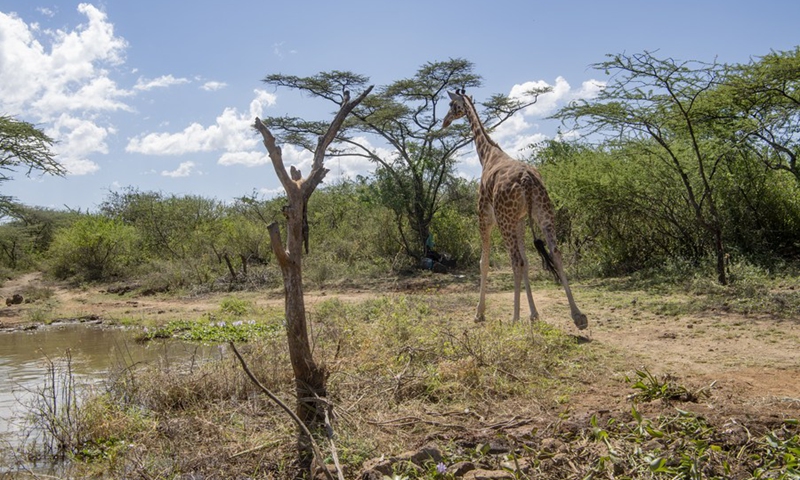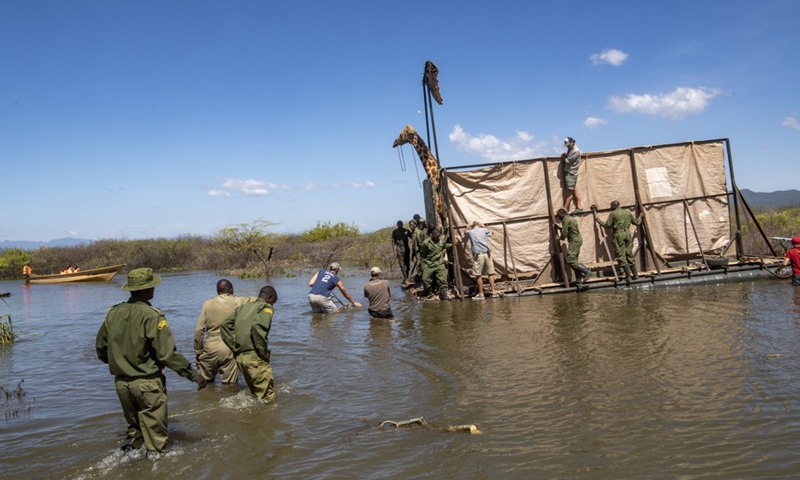Kenya rescues endangered Rothschild Giraffes from shrinking island amid rising water levels

An endangered Rothschild's giraffe is released to mainland Conservancy after the rescue by the Kenya Wildlife services wardens on a floater from Longicharo Island in Lake Baringo, North West of Nairobi, Kenya, Dec. 2, 2020.(Photo: Xinhua)

Kenya Wildlife services wardens assisted by volunteers put an endangered Rothschild's giraffe on a floater from Longicharo Island in Lake Baringo, North West of Nairobi, Kenya, Dec. 2, 2020.(Photo: Xinhua)
Kenya Wildlife Service (KWS) in conjunction with conservation partners has successfully rescued two endangered female Rothschild Giraffes that were marooned at Lake Baringo's Longicharo Island amid rising water levels.
The rescue mission that was conducted by KWS, Northern Rangeland Trust, Save Giraffes Now and Ruko Community Wildlife Conservation from Dec. 2 to 3, marked a milestone in the conservation of the iconic land mammals.
"We are happy to have been part of joint efforts to rescue the Rothschild Giraffes that are declining in number due to poaching for bushmeat, climate change and shrinking space," Patrick Omondi, KWS director of Biodiversity Research and Planning told Xinhua during an interview on Sunday.
Kenya is home to some 800 out of an estimated 3,000 Rothschild Giraffes found in Africa and their reintroduction at a conservancy in north-western Baringo county in 2011 aimed to enhance their survival in a natural habitat.
The relocation of an adult and juvenile female Rothschild Giraffes called Asiwa and Pasaka respectively from the sinking Longicharo Island to the mainland of Ruko Community Conservancy is expected to boost their capacity to breed devoid of interruptions.
The KWS approved relocation of the two iconic mammals from the fast-disappearing island where they risked starvation, attack by predators and disrupted breeding, to a custom-made sanctuary on the mainland.
"The survival of these giraffes is critical to our ongoing efforts to implement the National Giraffe Recovery Strategy covering 2020 to 2025," said Omondi.
"At the sanctuary, they are safe from the rising waters and they will be protected from predators, poachers and other threats," he added.
Currently, only six giraffes are holed up at the shrinking Lake Baringo island and their relocation to safer habitation in the mainland will be carried out next year.
The iconic species also known as Baringo Giraffe, came to epitomize the sustainability of community-based wildlife conservation model spearheaded by formerly warring Pokot and Ilchamus nomadic communities in north-western Kenya.
Aloise Naitirra, Baringo County director at Northern Rangeland Trust said a community conservation model that blends peacebuilding and income generation, has been a game-changer in protection of iconic species in Kenya.
He said that protecting giraffes at Ruko Community Conservancy, which is supported by Northern Rangeland Trust and donor agencies, has boosted tourism earnings in north-western Kenyan counties.
